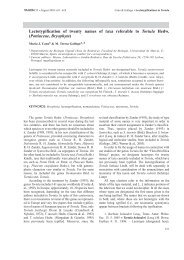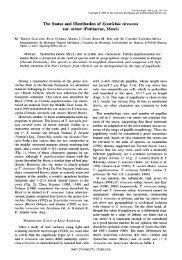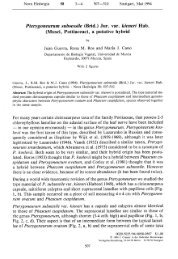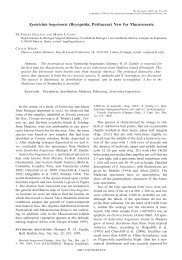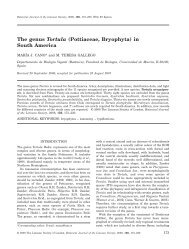Bryological Monograph An annotated checklist of the mosses of ...
Bryological Monograph An annotated checklist of the mosses of ...
Bryological Monograph An annotated checklist of the mosses of ...
Create successful ePaper yourself
Turn your PDF publications into a flip-book with our unique Google optimized e-Paper software.
MOSSES OF EUROPE AND MACARONESIA 243393. Hypnum holmenii was described from Canada,Greenland and Finland (<strong>An</strong>do, 1994), and has beenfound in <strong>the</strong> Arkhangelsk Oblast <strong>of</strong> Russia (Ignatov &Ignatova, 2004).394. Hypnum subimponens is reported from EuropeanRussia by Afonina (2004).395. Vesicularia sphaerocarpa (A.Jaeger) Broth. wasreported from Malta by Reimers in 1934 on <strong>the</strong> basis<strong>of</strong> a 19th century collection by Schweinfurth. Thespecimen (B) was destroyed in <strong>the</strong> Second World War,but Reimers in Bizot & Potier de la Varde (1952) wasconfident that it belonged to <strong>the</strong> taxon described by<strong>the</strong>se authors as V. reimersiana. According to Corleyet al. (1981), V. sphaerocarpa is a synonym <strong>of</strong> V.galerulata (Duby) Broth. Düll (1985) listed <strong>the</strong>Maltese plant as V. reimersiana, but also asserted thatV. galerulata had been found in mainland Italy.Corley & Crundwell (1991) accordingly added V.reimersiana to <strong>the</strong> list, retaining V. galerulata.However, no species <strong>of</strong> Vesicularia is listed for Italyby Cortini Pedrotti (2006 [2005]). It seems likely thatV. galerulata has never been found in Europe.396. Smith (2004) treated Heterocladium flaccidum as aspecies, but provided only a nomen nudum. He hasmade <strong>the</strong> necessary new combination above for this<strong>checklist</strong>, noting (pers. comm. to Hill) that consultationwith a number <strong>of</strong> British field bryologists revealedthat, with one exception, none had encounteredintermediates between it and H. heteropterum.397. Heterocladium wulfsbergii is discussed in detail byCrundwell & Smith (2000).398. Iwatsukiella leucotricha was listed for Europe byPodpěra (1954) under <strong>the</strong> name Habrodon leucotrichus(Mitt.) Perss., with a locality in <strong>the</strong> sou<strong>the</strong>rn Urals. Itwas omitted without comment by Corley et al.(1981), but is indicated from <strong>the</strong> European side <strong>of</strong><strong>the</strong> Urals by Dierssen (2001) and Ignatov & Ignatova(2004).399. Alpine and arctic forms <strong>of</strong> Hylocomium splendens havebeen variously treated. Var. alpinum Schlieph. exLimpr. is mapped by Söderström (1996), but isdoubted and treated as possibly a synonym <strong>of</strong> var.obtusifolium (Geh.) Paris by Koperski et al. (2000).Var. obtusifolium is commonly treated as a synonym<strong>of</strong> H. alaskanum (Lesq. & James) Austin, whosedistinguishing characters have been shown by Ross etal. (2001) to be mainly under environmental ra<strong>the</strong>rthan genetic control. It is not clear whe<strong>the</strong>r any <strong>of</strong><strong>the</strong>se forms is sufficiently distinct genetically todeserve taxonomic recognition.400. Herzogiella adscendens (Lindb.) Z.Iwats. & W.B.Sch<strong>of</strong>ieldhas been reported from Svalbard (Corley &Crundwell, 1991; Düll, 1985), but <strong>the</strong> recordwas subsequently rejected (Frisvoll & Elvebakk,1996).401. Myurella julacea var. ciliata (Chal.) Ochyra &Bednarek-Ochyra (syn. M. julacea var. scabrifoliaLindb. ex Limpr.) is treated as distinct in someEuropean countries, but intergrades completely withvar. julacea. It is not recognized here.402. Ortho<strong>the</strong>cium chryseon is incorrectly listed as O.chryseum by Crosby et al. (1999). It was described asHypnum chryseon by Schwägrichen (1804).403. Plagio<strong>the</strong>cium curvifolium is sometimes treated as avariety (in Europe) or synonym (in North America)(Ireland, 2003) <strong>of</strong> P. laetum, to which it is undoubtedlyvery close. As a variety, its correct name is P. laetumvar. secundum.404. Plagio<strong>the</strong>cium denticulatum var. undulatum is treatedin many European lists as a species, P. ru<strong>the</strong>i, but inNorth America merely as a synonym <strong>of</strong> P. denticulatum(Ireland, 2003). It is not clearly distinct from var.denticulatum, and we follow Ignatov & Ignatova(2004), Koperski et al. (2000) and Smith (2004) intreating it as a variety.405. Plagio<strong>the</strong>cium noricum was described from <strong>the</strong>Pinzgau, Austria and was thought by Molendo(but not Limpricht) to intergrade with P. neckeroideum.Grims (1999) listed it but noted that Düll(1992) had thought it a weak species, possiblyonly a variety <strong>of</strong> P. neckeroideum. It is not recognizedhere.406. Plagio<strong>the</strong>cium succulentum is a difficult taxon,intergrading on <strong>the</strong> one hand with P. nemorale(Hemeric, 1989) and on <strong>the</strong> o<strong>the</strong>r with P. cavifolium(Nyholm, 1965). It is also very close to P. platyphyllum.It is retained here, because it cannot satisfactorilybe subordinated to any <strong>of</strong> <strong>the</strong>se species withouttreating <strong>the</strong> whole group as a single, ra<strong>the</strong>r-broadspecies.407. Plagio<strong>the</strong>cium svalbardense was described by Frisvollin Frisvoll & Elvebakk (1996).408. Pseudotaxiphyllum laetevirens was raised to speciesrank by Hedenäs (1992a).409. Entodon challengeri occurs in European Russia(Ignatov & Ignatova, 2004) and is <strong>the</strong> correct namefor <strong>the</strong> plant formerly known as E. compressus(Iwatsuki & Tan, 2001).410. According to Ochyra & Ireland (2004), Isopterygiumtenerum is absent from Europe but present in sub-Saharan Africa. However, Schumacker in Stewart(1995), Cortini Pedrotti (2006 [2005]) and Gabrielet al. (2005) list it for Italy and <strong>the</strong> Azores.Isopterygium bottinii was excluded from Sematophyllumby Guerra & Gallego (2005), and is includedhere in I. tenerum.411. Hageniella micans, previously known from Europeand North America, was synonymized with H.pacifica Broth., which occurs in China and Taiwan(Tan & Jia, 1999).412. Sematophyllum adnatum was found in Italy, where it isthought to be an introduction from North America(Brusa in Blockeel et al., 2000).




